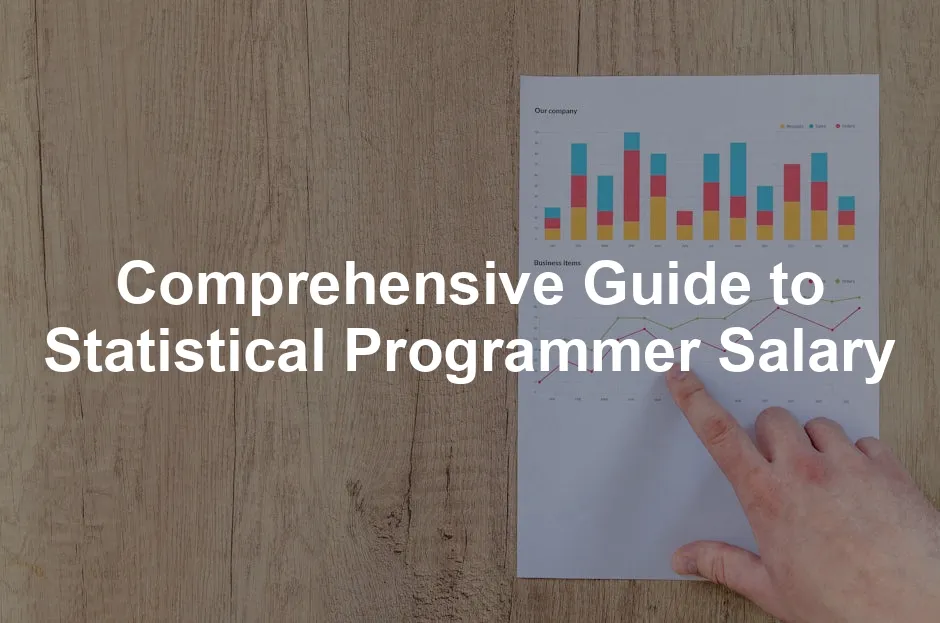Introduction
Statistical programmers play a crucial role in data analysis, particularly in industries like pharmaceuticals and healthcare. They work behind the scenes, transforming raw data into meaningful insights that drive decisions. Without their expertise, the vast amounts of data generated would remain an indecipherable jumble of numbers.
The salary landscape for statistical programmers can be quite varied. Several factors come into play, such as experience, geographical location, and the specific industry in which they work. For instance, a programmer in a bustling metropolis may earn more than one in a smaller town. Furthermore, those working in high-demand sectors like pharmaceuticals often command higher salaries compared to their counterparts in academia or other fields.
This article aims to provide a detailed overview of statistical programmer salaries. We will explore the factors that influence pay, offer comparisons by region, and share career insights. Whether you’re contemplating a career in this field or seeking to negotiate a raise, understanding the salary landscape can empower your decisions. Let’s get into the nitty-gritty of what you can expect as a statistical programmer in today’s job market.
To kickstart your journey into the world of data science, consider diving into a comprehensive resource like Data Science for Dummies. This book serves as a friendly introduction to the field, making complex concepts more digestible and helping you build a solid foundation.
To learn more about the skills and knowledge required for this career, check out this comprehensive guide to becoming a statistical programmer.
Understanding the Role of a Statistical Programmer
Job Description
Statistical programmers are the backbone of data analysis. Their key responsibilities include data preparation, statistical analysis, and generating comprehensive reports. They work with large datasets, ensuring that the data is clean, accurate, and ready for analysis.
They are tasked with designing and validating statistical programs, often using software like SAS or R. This involves not just crunching numbers, but also creating visual representations of data to communicate findings effectively. Moreover, they might assist in training other team members, fostering a collaborative environment.
If you’re looking to enhance your skills in R programming, the R Programming for Data Science book is a fantastic choice. It guides you through the nuances of R, making it easier to apply this powerful tool to your programming tasks.
Required Skills
To excel as a statistical programmer, certain essential skills are required. Proficiency in statistical programming languages such as SAS and R is a must. Familiarity with data analysis techniques and tools is equally important. Problem-solving abilities play a vital role, as programmers often encounter unexpected issues that require innovative solutions.
Additionally, strong attention to detail is critical, as even minor errors can lead to significant ramifications in data interpretation. Communication skills are also necessary, as statistical programmers must convey complex ideas in a clear and concise manner.
Educational Background
Most statistical programmers possess degrees in fields such as statistics, mathematics, or computer science. These educational paths provide a solid foundation in the principles of data analysis and programming. While a bachelor’s degree may suffice, candidates often boost their prospects by pursuing advanced degrees or certifications.
Certifications in specialized software or methodologies can set candidates apart in a competitive job market. For instance, obtaining a certification in SAS or similar programs can enhance a programmer’s credibility and marketability, potentially leading to better job opportunities and higher salaries.
If you want a structured approach to your preparation, consider the SAS Programming Certification Study Guide. This resource is designed to help you master the material and ace your certification exam.
In summary, statistical programmers play a vital role in the data-driven landscape of modern industries. Their expertise not only influences the quality of insights derived from data but also impacts decision-making processes at various organizational levels.

Salary Overview by Country
Statistical Programmer Salary in the United States
As of October 2024, the average salary for a statistical programmer in the United States is a hefty $76,607. These numbers can fluctuate quite a bit, with salaries ranging from $68,621 to $85,966. Not too shabby, right? But hold onto your calculators—let’s break it down further.
When it comes to experience, this field is like a fine wine; it gets better with age. Entry-level positions see salaries around $59,000. Mid-level programmers, those who’ve gathered a bit of dust on their resumes, earn between $76,607 and $100,000. For our seasoned veterans—senior programmers—the sky’s the limit, with salaries soaring from $100,000 to a whopping $150,000. Clearly, experience pays off!
To help you understand data analysis better, consider picking up Data Analysis with R and RStudio. This book offers practical approaches to analyzing data and visualizing results, making it an essential read for aspiring programmers.

Salary in Europe
Now, let’s hop across the pond to Europe and see how salaries stack up. In Germany, for instance, the average salary for a statistical programmer is about €53,656 (around $58,000). The salary range here is between €35,000 and €79,000. In the UK, mid-level salaries hover around $50,000 to $60,000, while in France, they can dip as low as €35,000 to €40,000. Ouch!
So, what’s behind these lower figures compared to the US? One major factor is the cost of living differences. In Europe, a significant portion of expenses like healthcare and education is often covered by the state, which can lead to lower salary offers. Additionally, the demand for statistical programmers tends to be less intense than in the US, especially in booming sectors like pharmaceuticals.
Global Perspective
Looking at the global scene, the average salary for statistical programmers in 2024 is around USD 126,625. That’s quite a leap! However, this number varies significantly depending on the region. For instance, programmers in developed markets typically earn more than their counterparts in developing countries.
In North America, salaries can reach as high as USD 218,000 for the top 10% of earners, while in other parts of the world, such as Asia or Africa, figures might be considerably lower. This discrepancy highlights the importance of local market conditions, economic stability, and industry demands.
In conclusion, whether you’re eyeing a career in statistical programming or just curious about the numbers, it’s clear that salaries vary widely based on location, experience, and market demand. Understanding these dynamics can help you navigate your career path more effectively and make informed decisions about your future.

Location
Geographical location plays a pivotal role in determining the salary of statistical programmers in the United States. Some areas are simply more lucrative than others, often thanks to the demand for skilled professionals. For instance, states like California and New York are hotbeds for high-paying opportunities.
In California, particularly the San Francisco Bay Area, the average salary for a statistical programmer can soar to around $103,000. That’s not just pocket change! New York City follows closely, with average figures of about $92,000. Other notable mentions include Massachusetts and New Jersey, where salaries hover around $90,000.
On the flip side, programmers in states like Kentucky and West Virginia earn significantly less, often under $70,000. This stark contrast highlights how regional demand and cost of living can influence salaries.

Industry
The industry in which a statistical programmer works can dramatically affect their salary. For instance, those employed in the pharmaceutical sector tend to earn the most, with salaries reaching up to $100,000 or more for mid-level positions. The healthcare industry also offers competitive pay, particularly in roles tied to clinical trials and research.
In contrast, salaries in the academic sector tend to lag behind. While academia provides job stability, it often doesn’t match the financial rewards found in pharmaceuticals or healthcare. A mid-level programmer in academia might earn around $76,000, which is a significant drop compared to their counterparts in more lucrative industries. The disparity underlines the importance of choosing the right industry for career advancement.
Company Size and Reputation
The size and reputation of a company have a significant impact on salary levels. Larger organizations often have more resources and can offer higher salaries. For instance, a statistical programmer at a well-known pharmaceutical company such as Genentech might see salaries exceeding $113,000.
Conversely, smaller companies or startups might offer less upfront but could provide equity or other benefits that could be more valuable in the long run. It’s a trade-off that many programmers must consider. Additionally, reputable companies tend to attract top talent, which can create a competitive salary environment.

Salary Breakdown by Experience Level
Entry-Level Salaries
Entry-level salaries for statistical programmers typically start around $59,000. Fresh graduates often secure roles as Junior Programmers or Data Analysts. These positions focus on data preparation and quality control, providing a solid foundation for future growth.
Many entry-level programmers find themselves in dynamic environments, working closely with seasoned professionals. This mentorship is invaluable, as it provides insights into the industry and paves the way for career advancement.
If you’re looking for a fun way to unwind after a long day of coding, consider indulging in a Adult Puzzle Book. It’s a fantastic way to relax while keeping your mind sharp!

Mid-Level Salaries
As programmers gain experience, their salaries reflect their growing expertise. Mid-level positions usually offer salaries ranging from $76,607 to $100,000. These roles often involve more complex data analysis, project management, and possibly leading small teams.
In this stage, programmers are expected to handle statistical programming with greater independence and contribute to strategic decision-making. This increased responsibility is well-compensated, as companies recognize the value of skilled professionals who can drive results.

Senior-Level Salaries
Senior positions in statistical programming command impressive salaries, often between $100,000 and $150,000. These roles typically involve overseeing projects, mentoring junior staff, and ensuring compliance with regulatory standards.
Senior programmers are often the go-to experts for complex statistical problems and play a crucial role in shaping data strategy within their organizations. Their experience and leadership abilities make them highly sought after, leading to lucrative compensation packages that reflect their expertise.

Benefits and Perks
Common Benefits
Statistical programmers enjoy a range of benefits that enhance their overall job satisfaction. Health insurance is typically a given, covering medical, dental, and sometimes vision needs. In fact, according to recent surveys, 71% of SAS programmers in Germany receive medical coverage. That’s a win for both health and peace of mind!
Retirement plans are another essential perk. Many companies offer 401(k) plans with matching contributions, making it easier to save for that sunny retirement on the horizon. Who wouldn’t want a cozy beach chair after crunching numbers for years?
Remote work options have gained significant traction, especially post-pandemic. More firms are allowing statistical programmers to work from home or adopt hybrid models. This flexibility can lead to a better work-life balance, allowing programmers to swap their business attire for comfy pajamas while still delivering top-notch results.

For those long coding sessions, noise-canceling headphones can be a lifesaver! Check out these Noise-Canceling Headphones to help you focus without distractions!
Unique Perks
Beyond the basics, companies often sweeten the deal with unique perks. Flexible hours are becoming increasingly popular, allowing programmers to start and end their workdays at times that suit them best. This means no more rushing through morning traffic—just pure programming bliss!
Professional development opportunities also stand out. Many organizations invest in their employees by offering training programs, workshops, and even tuition reimbursement. This not only helps statistical programmers to sharpen their skills but also positions them for promotions and higher salaries down the line.
Team events and outings can add a touch of fun to the work environment. Whether it’s a casual Friday pizza party or an adventurous team-building retreat, these activities foster camaraderie and make the workplace feel like a second home.
In summary, the benefits and perks associated with statistical programming roles are designed to support both personal and professional growth. From healthcare and retirement plans to flexible hours and development opportunities, these perks play a vital role in attracting and retaining top talent in the field.

Career Advancement and Salary Growth
Pathways for Advancement
Career advancement opportunities abound for statistical programmers. With the right mix of experience and skill, one can ascend from entry-level roles to mid-level positions and eventually into senior management. Obtaining additional certifications is a fantastic way to boost your credentials. For instance, a certification in R can showcase your expertise and make you a more attractive candidate for promotions.
Transitioning into management roles is another promising pathway. Many statistical programmers take on team leader responsibilities, guiding junior staff and overseeing projects. This not only enhances leadership skills but can also lead to significant salary increases. Companies recognize the value of those who can lead effectively while still delivering high-quality statistical analyses.

Strategies to Increase Salary
Want to boost your salary? Networking is a powerful tool. Building connections within the industry can open doors to new opportunities. Attend industry conferences or engage with professionals on platforms like LinkedIn. You never know when a casual conversation might lead to your next job offer!
Further education is another strategy worth considering. Pursuing a master’s degree or specialized training can enhance your qualifications and make you more competitive in the job market. In the rapidly evolving field of data science, staying updated with the latest trends and technologies is crucial.
Lastly, don’t shy away from salary negotiations. Knowing your worth and having data to back it up can lead to successful discussions with employers. After all, if you don’t ask, you won’t get!
In conclusion, career advancement and salary growth for statistical programmers are very much within reach. By obtaining certifications, networking, furthering education, and negotiating effectively, you can pave the way for a successful and lucrative career in this exciting field.

Conclusion
Understanding the salary landscape for statistical programmers is crucial for anyone considering a career in this field. Throughout this article, we’ve explored how salaries can vary significantly based on factors such as experience, location, and industry.
For instance, entry-level programmers might start around $59,000, while seasoned professionals can earn upwards of $150,000, particularly in high-demand sectors like pharmaceuticals. Additionally, geographical location plays a vital role; states like California and New York offer higher salaries compared to others.
Recognizing these factors helps individuals make informed decisions about their career paths. Salary trends fluctuate, so keeping an eye on the latest data is essential for effective career planning.
Ultimately, it’s important for readers to conduct further research tailored to their unique situations. Whether you’re negotiating a salary or contemplating a job change, understanding your worth in the market is key. So, keep your calculators handy, and don’t hesitate to dig deeper into the factors that influence your earning potential!

FAQs
What is the average salary for a statistical programmer?
The average salary for a statistical programmer varies by region. In the United States, it’s around $76,607, with entry-level positions at $59,000. In Europe, salaries are typically lower; for example, in Germany, the average is about €53,656 (around $58,000). In the UK, salaries for mid-level programmers hover between $50,000 and $60,000. The global average salary is approximately USD 126,625, indicating significant disparities based on location and market demand.
How does experience affect salary?
Experience has a direct impact on salary. Entry-level programmers earn about $59,000, while those with 5-9 years of experience can see their salaries rise to between $76,607 and $100,000. For senior positions, salaries typically range from $100,000 to $150,000, rewarding the expertise and leadership that comes with years in the field. Thus, gaining experience is crucial for salary growth in this profession.
What skills can help increase a statistical programmer’s salary?
Several skills can enhance a statistical programmer’s earning potential. Proficiency in programming languages like SAS and R is essential. Additionally, certifications in these languages can make candidates more attractive to employers. Skills in data analysis, problem-solving, and project management also contribute to higher salaries. The more diverse your skill set, the better your chances of landing lucrative opportunities.
Are there remote opportunities for statistical programmers?
Yes, remote work opportunities for statistical programmers have become increasingly available, especially post-pandemic. Many companies now offer flexible work arrangements, allowing programmers to work from home. This shift can influence salary, as some firms may adjust pay based on the cost of living in different regions. However, remote positions often provide access to a wider range of job opportunities, potentially leading to higher salaries.
How can I negotiate my salary as a statistical programmer?
Negotiating your salary effectively requires preparation and market research. Start by gathering data on average salaries for your position in your area. Highlight your skills, experience, and any relevant certifications during discussions. Practice your negotiation skills beforehand, and be ready to articulate your value to the company. Remember, confidence and preparation are your best allies in securing the salary you deserve!
Please let us know what you think about our content by leaving a comment down below!
Thank you for reading till here 🙂
All images from Pexels




